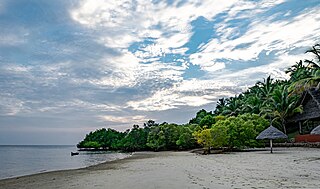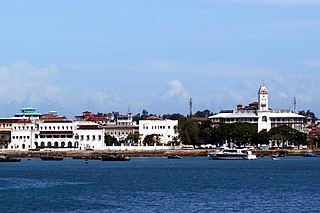
Zanzibar is an insular semi-autonomous province which united with Tanganyika in 1964 to form the United Republic of Tanzania. It is an archipelago in the Indian Ocean, 25–50 km (16–31 mi) off the coast of the African mainland, and consists of many small islands and two large ones: Unguja and Pemba Island. The capital is Zanzibar City, located on the island of Unguja. Its historic centre, Stone Town, is a World Heritage Site.

Pemba Island is a Tanzanian island forming part of the Zanzibar Archipelago, lying within the Swahili Coast in the Indian Ocean.

Mafia Island or Chole Shamba is an island of The Mafia Archipelago located in Mafia District in the southern Pwani Region of Tanzania. The island is the third largest in Tanzanian ocean territory, but is not administratively included within the semi-autonomous region of Zanzibar, which has been politically separate since 1890. Mafia Island forms the largest part of Mafia District, one of the six administrative districts in the Pwani Region. As the Mafia Archipelago's main islan, is sometimes called Chole shamba in meaning Chole farmlands Swahili. This is in opposition to the historic settlement of Chole Mjini(Chole town) on Chole Island inside Mafia Bay. The island's population is over 40,000. The economy is based on fishing, subsistence agriculture and the market in Kilindoni. The island attracts some tourists, mainly scuba divers, birdwatchers, game fishermen, and people seeking relaxation.

Stonetown of Zanzibar, also known as Mji Mkongwe, is the old part of Zanzibar City, the main city of Zanzibar, in Tanzania. The newer portion of the city is known as Ng'ambo, Swahili for 'the other side'. Stone Town is located on the western coast of Unguja, the main island of the Zanzibar Archipelago. Former capital of the Zanzibar Sultanate, and flourishing centre of the spice trade as well as the slave trade in the 19th century, it retained its importance as the main city of Zanzibar during the period of the British protectorate. When Tanganyika and Zanzibar joined each other to form the United Republic of Tanzania, Zanzibar kept a semi-autonomous status, with Stone Town as its local government seat.

Kilwa Kisiwani is an island, national historic site, and hamlet community located in the township of Kilwa Masoko, the district seat of Kilwa District in the Tanzanian region of Lindi Region in southern Tanzania. Kilwa Kisiwani is the largest of the nine hamlets in the town Kilwa Masoko and is also the least populated hamlet in the township with fewer than 1,000 residents.
The Swahili people comprise mainly Bantu, Afro-Arab and Comorian ethnic groups inhabiting the Swahili coast, an area encompassing the Zanzibar archipelago and mainland Tanzania's seaboard, littoral Kenya, northern Mozambique, the Comoros Islands, southwestern Somalia and Northwest Madagascar.

Kilwa District is one of six administrative districts of Lindi Region in Tanzania. The District covers an area of 15,000 km2 (5,800 sq mi). The district is comparable in size to the land area of the nation state of East Timor. Kilwa district is bordered to the north by Rufiji District in Pwani Region, to the east by the Indian Ocean, to the south by the Lindi District, Nachingwea District together with Ruangwa District, and to the west by the Liwale District. The district borders every other district in Lindi Region except Lindi Municipal District. The district seat (capital) is the town of Kilwa Masoko. The district is named after the medieval Swahili city state of Kilwa Kisiwani. According to the 2012 census, the district has a total population of 190,744.

Pwani Region is one of Tanzania's 31 administrative regions. The word "Pwani" in Swahili means the "coast". The regional capital is the town of Kibaha. The Region borders the Tanga Region to the north, Morogoro Region to the west, Lindi Region to the south, and surrounds Dar es Salaam Region to the east. The Indian Ocean also borders the region to its northeast and southeast. The region is home to Mafia Island, the Rufiji delta and Saadani National Park. The region is home to Bagamoyo town, a historical Swahili settlement, and the first colonial capital of German East Africa. According to the 2012 national census, the region had a population of 1,098,668, which was slightly lower than the pre-census projection of 1,110,917. From 2002 to 2012, the region's 2.2 percent average annual population growth rate was the seventeenth-highest in the country. It was also the 21st most densely populated region with 34 people per square kilometre., the region is slightly larger than Belgium.

The Swahili coast is a coastal area of the Indian Ocean in East Africa inhabited by the Swahili people. It includes Dar es Salaam; Sofala ; Mombasa, Gede, Pate Island, Lamu, and Malindi ; and Kilwa. In addition, several coastal islands are included in the Swahili coast such as Zanzibar and Comoros.

Tumbatu is historic Swahili settlement located on Tumbatu Island, Kaskazini A District of Unguja North Region in Tanzania. This site is a significant archaeological site that contains a large number of collapsed coral stone structures including private houses and several mosques, the largest of which is located on the shore facing the village of Mkokotoni on Unguja. Pearce initially looked into the ruins in 1915 and wrote about the mosques, palace, and other stone homes.

Mafia Island Marine Park is a protected marine park with the IUCN category VI around the Mafia Archipelago in the Indian Ocean's sea of Zanj. It is administratively located in the jurisdiction Mafia District of Pwani Region in Tanzania.

The East African mangroves are a mangrove ecoregion consisting of swamps along the Indian Ocean coast of East Africa in Mozambique, Tanzania, Kenya and southern Somalia.
The Shirazi people, also known as Mbwera, are a Bantu ethnic group inhabiting the Swahili coast and the nearby Indian ocean islands. They are particularly concentrated on the islands of Zanzibar, Pemba and Comoros.

Mafia District Council(Wilaya ya Mafia, in Swahili) is one of six administrative districts of Pwani Region in Tanzania. It adminsiters not only the main Mafia Island but the entire Mafia Archipelago. The District covers an area of 642.6 km2 (248.1 sq mi). The Sea of Zanj completely encircles the District. Rufiji District is located on the other side of the Mafia Channel to the west. The district is comparable in size to the land area of Saint Lucia. The town of Kilindoni serves as its administrative capital. The District is home to the largest concentration of Whale Sharks in Africa, Mafia Island Marine Park, Historic Chole Island Ruins and Mlola Forest Reserve. According to the 2012 Tanzania National Census, the population of the District was 46,438.

The Marine Park and Reserves Unit of Tanzania was formed in 1994 under the Marine Parks and Reserve Act No 29, of 1994. The headquarters are located in Upanga West ward of Ilala District in Dar es Salaam Region. Previously all marine life and biodiversity was under the Ministry of Livestock and Fisheries. The population along the 1400 km Tanzanian coastline has reached to over 10 million and the increase in number of people whose livelihood depends on the marine resource has also increased. The increase in population has caused various threats to the marine life due to over fishing, coral mining and unplanned increase in settlements. To protect the marine biodiversity the Government of Tanzania established the Marine Park and Reserves unit in 1994 with Mafia Island Marine Park as the first marine park.
The East African coral coast is a marine ecoregion along the eastern coast of Africa. It extends along the coasts of Kenya, Tanzania, and northern Mozambique, from Lamu in Kenya to Angoche in Mozambique. It adjoins the Northern Monsoon Current Coast ecoregion to the north, and the Bight of Sofala/Swamp Coast ecoregion to the south.

National Historic Sites of Tanzania is an official list of places in Tanzania that have been designated as National Historic Sites as per the Ministry of Natural Resources and Tourism of Tanzania under the Antiquities Division. The list is not complete and is currently being updated.

Chole Island Ruins is a national historic site located on Chole Island of Jibondo ward in Mafia District of Pwani Region in Tanzania. The ruined mosques are from the 14th century, whereas other remains that have survived are often considerably more recent, from the 18th century. Even though the remains are in disrepair and are difficult to navigate, the largest standing ruin is a massive double-story building with stone staircases and a labyrinth of anterooms.

The Mafia Archipelago or The Mafia Islands is an group of islands in the Mafia District of Pwani Region's coast on the Sea of Zanj in Tanzania's Indian Ocean coast. The archipelago is composed of 9 islands and around 12 coral reefs. In total, the archipelago Mafia archipelago covers 972 km2 (375 sq mi) in total, of which 8.5 km2 (3.3 sq mi) 407 km2 are land and 565 km2 are water. and has an average elevation of 53 m (174 ft). The nine Islands in the archipelago are. The largest island in the archipelago is Mafia Island also known as Chole Shamba locally. The other eight islands inside Mafia District in addition to Mafia Island are; Juani Island, Chole Island, Jibondo Island (Kibondo), Bwejuu Island, Shungumbili Island (Thanda), Barakuni Island, Miewi Island, and Niororo Island (Nyororo).

Kua or Ruins of Kua is a Medieval Swahili, National Historic Site located in Jibondo ward of Mafia District in Pwani Region of Tanzania. The site is located on Juani Island of the Mafia Archipelago. As of 2016, the site is currently on the list of 50 at-risk cultural heritage sites in 36 countries.

















